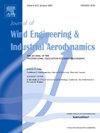Assessment of driving safety and comfort during vortex-induced vibrations in a long-span bridge considering wind-vehicle-bridge interactions
IF 4.2
2区 工程技术
Q1 ENGINEERING, CIVIL
Journal of Wind Engineering and Industrial Aerodynamics
Pub Date : 2025-02-01
DOI:10.1016/j.jweia.2025.106007
引用次数: 0
Abstract
Vortex-induced vibration (VIV) has a detrimental influence on the traffic management of bridges and threatens driving safety and comfort. To quantitatively assess driving safety and comfort under VIV conditions, this study incorporates a nonlinear vortex-excited force aerodynamic model to simulate VIVs based on the classic theory of wind-vehicle-bridge interactions. Based on the wheel load reduction rate and acceleration response to vehicle vibration, driving safety and comfort are analyzed from the perspective of vehicle dynamic performance. A novel approach is firstly proposed to quantify the influence of blind area on driving safety by incorporating the concept of stopping sight distance, along with the introduction of a general fitting formula to address this issue. Additionally, the factors influencing drivers’ vision under VIV are discussed, including height, distance and time-history. This study provides a comprehensive comparison of the permitted limits on VIV amplitudes from the perspectives of driving safety and comfort, highlighting the significance of considering the comfort index based on vehicle dynamic response. This approach effectively addresses the shortcomings of existing specifications in assessing driving comfort while proposing formulations for calculating VIV amplitude limits at different vehicle speeds, aiming to increase the maximal transportation capacity.
考虑风-车-桥相互作用的大跨度桥梁涡激振动行驶安全性与舒适性评价
涡激振动严重影响桥梁的交通管理,威胁行车安全与舒适。为了定量评估在涡激振动条件下的驾驶安全性和舒适性,本研究基于经典的风-车-桥相互作用理论,采用非线性涡激力气动模型对涡激振动进行仿真。基于车轮减载率和加速度对车辆振动的响应,从车辆动态性能的角度分析了行驶安全性和舒适性。首先提出了一种新的方法,通过引入停车视距的概念来量化盲区对驾驶安全的影响,并引入了通用的拟合公式来解决这一问题。此外,还讨论了影响驾驶员视觉的因素,包括高度、距离和时间历史。本研究从驾驶安全性和舒适性的角度全面比较了车辆的振动振幅允许限值,突出了考虑基于车辆动态响应的舒适性指标的重要性。该方法有效地解决了现有规范在评估驾驶舒适性方面的不足,同时提出了不同车速下的VIV振幅限制计算公式,旨在提高最大运输能力。
本文章由计算机程序翻译,如有差异,请以英文原文为准。
求助全文
约1分钟内获得全文
求助全文
来源期刊
CiteScore
8.90
自引率
22.90%
发文量
306
审稿时长
4.4 months
期刊介绍:
The objective of the journal is to provide a means for the publication and interchange of information, on an international basis, on all those aspects of wind engineering that are included in the activities of the International Association for Wind Engineering http://www.iawe.org/. These are: social and economic impact of wind effects; wind characteristics and structure, local wind environments, wind loads and structural response, diffusion, pollutant dispersion and matter transport, wind effects on building heat loss and ventilation, wind effects on transport systems, aerodynamic aspects of wind energy generation, and codification of wind effects.
Papers on these subjects describing full-scale measurements, wind-tunnel simulation studies, computational or theoretical methods are published, as well as papers dealing with the development of techniques and apparatus for wind engineering experiments.

 求助内容:
求助内容: 应助结果提醒方式:
应助结果提醒方式:


